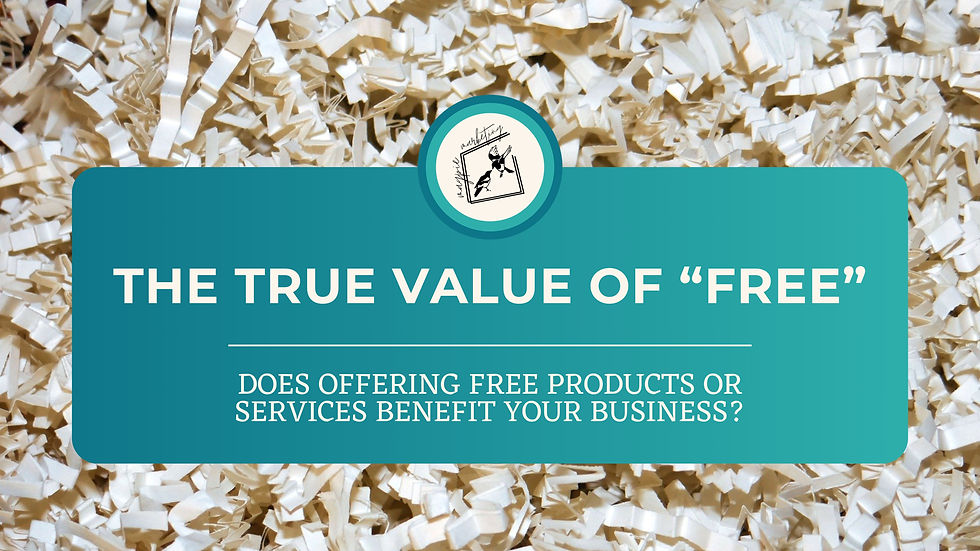- nienhuismadison
- May 22
- 5 min read

Marketing is often misunderstood or lumped in with sales and advertising. It is such a broad scope of operating a business that while it isn’t sales, it’s not not sales. Confused? Most people are! It looms over businesses with threats of declining business or great success. But what is it, truly, and how can it help your business?
First, let’s dive into the dictionary definition: “the activity or business of promoting and selling products or services, including market research and advertising.” Such ambiguity is bound to bubble confusion in anyone diving into the world of marketing. Let’s simplify it further:
Marketing is simply letting other people know you, your business, or your product/service exist.
Easy, right? When you begin your marketing with this thought in mind, it can bring clarity to your next steps. Every business is entirely unique. Even among similar businesses, their marketing can and should vary. We can’t all be doing the same thing or it defeats the purpose of marketing yourself. Letting other people know you and your business exist can be separated into three different categories:

Sphere of Influence
Your sphere of influence (often referred to as “SOI”) represents people you already know. This could be your family, friends, people you know on social media, even acquaintances. Your goal here is to regularly remind them that you have a business, and if they need your product or services, they should use you rather than a complete stranger.
This doesn’t have to look like you bombarding your friends and family to buy what you’re selling. It could simply mean staying in touch on a business level with them: posting to your personal social media your business posts, adding them to a quarterly email list just for friends and family that’s more personal, or even sending them branded gifts for birthdays or Christmas.
The worst feeling in the world is seeing your family member leverage your competition, not out of spite, but because they forgot you have a business. We want to avoid those yucky and awkward feelings all around. So keep reminding them in whatever way works with your budget, schedule, and personality.

Past Customers
Past customers—or people who have used your product or service in the past— are some of the most important people to market to. It’s important to nurture and prioritize these relationships, as a referral-based business is ideal in any industry. Yep, you read that right: any industry. It doesn’t matter if you sell clothes or real estate, having your past clients generate organic business on your behalf is invaluable.
How do you prioritize and market to this group? That’s entirely up to you, which can be both freeing and frustrating. You could do anything, but where should you start? What’s the most important way to market?
The best way to nail down this broad question is to figure out your budget, time, and your personality. If you have a few hundred dollars a month, gifting or regular events are an excellent way to stay in front of past customers and build trust. If your budget is zero dollars, it may be time to get serious about social media marketing. Those silly videos can generate you business. Get consistent, and then start following marketing and social media pages to glean insights that you can apply when it feels right. Find what works with you and aligns with your values. Try a few tactics and see what not only gets results but what starts to feel like a fun challenge instead of something you dread.

Potential Customers
These people are anyone who doesn’t know you and hasn’t worked with you in the past. But even that is a little too simple—this segment should be a little more particular. Think “ideal customer.” Marketing to everyone on planet Earth may feel like a great way to get customers, but it can fizzle out with little results. Your business isn’t for everyone. You aren’t for everyone! Defining who you are, what you represent, and how that translates to your business is an excellent first step.
The next step in finding your ideal customer is to think back on customers that you loved working with. They were fun, kind, patient, and you could see yourself being friends outside of business. Think about how they heard about you, what drew them to you, and their personality. Now mish mash every person you thought of and that is your ideal customer. Don’t market blindly—market to the people who make your business fun!
Now that you know the who of marketing, let’s dive into the what. We mentioned a few earlier, and we’ll list them shortly, but it’s important to know that marketing is a jumble. It’s a mess of an industry that means whatever the job description under the role “Marketing” is. It is whatever you want it to be, as long as it’s about letting people know you exist. The “what” can be divided into four segments as well:

Digital Marketing
Digital marketing is anything digital that promotes your business. Social media, websites, Google Business, email marketing, and more. Anything online that let’s people know you exist belongs in this category.

Print Marketing
Newspaper ads, magazines, booklets, flyers, billboards, and postcards are all considered print marketing. If it involves using tangible, physical materials to remind people your business exists you can bet it belongs here.

Event Marketing
Events are a great way to market your business when done right. These can bring people into your shop, get people on your mailing list, or just expose people to who you are. A customer appreciation event is also a great way to reward past clients for being loyal.

Gifting
Gift marketing is a little blurry, and depending on your industry may be highly regulated (looking at you, realtors and lenders). This category of marketing is any time you do a giveaway of any kind. Spending money on a physical product (that could be yours, branded to you, or something completely random) and gifting it to someone outside of your business with no strings attached. A social media giveaway is a great example, as well as monthly “drip” campaigns where you package and send gifts.
Marketing (Hopefully) Simplified
We hope this blog post has de-mystified marketing for you and your business. While some may tout it’s only one of these aspects, we know it’s just a concept, not something physical, and therefore its meaning has changed over time. As the world evolves, so will marketing. People are constantly changing their buying habits, and marketing will always adjust. If you’re confused, know that is not unusual. Marketing is weird.
While there wasn’t any direct advice here, we hope you can take your foundation of knowledge you’ve been working on and begin to experiment with your business. There is no one-size-fits-all approach, as every business is unique. But you don’t have to do this alone: if you’re looking for real, human support, contact us today to get started. We’d love to dive into your needs and expand your business with you.







Comments